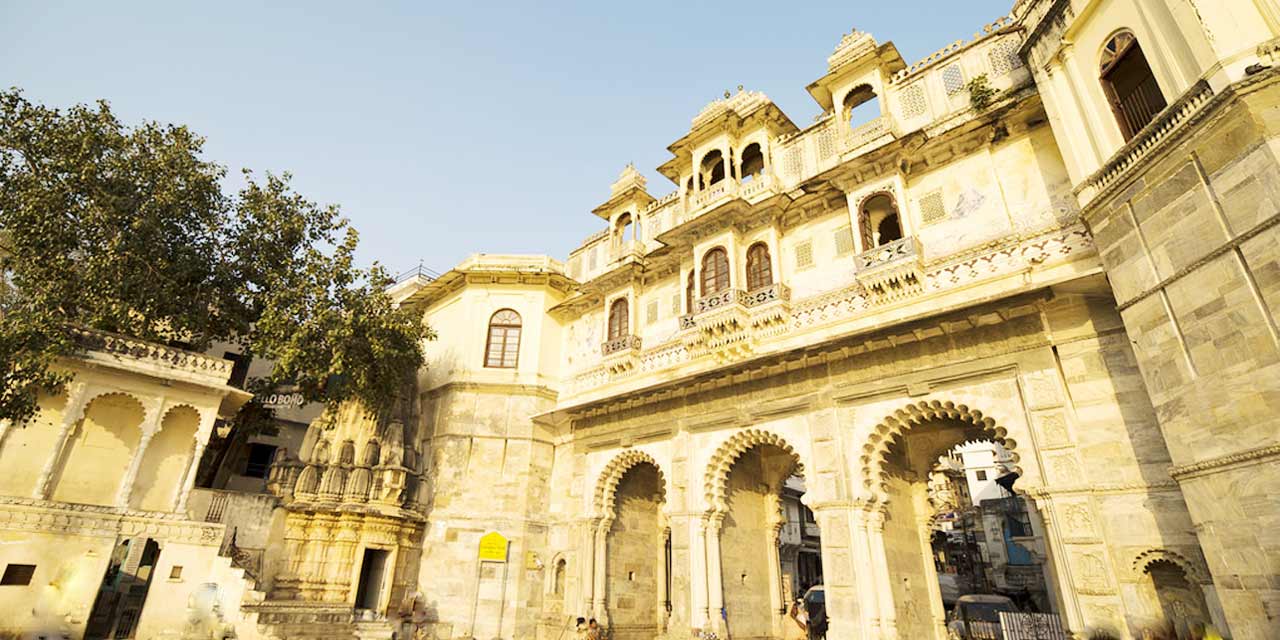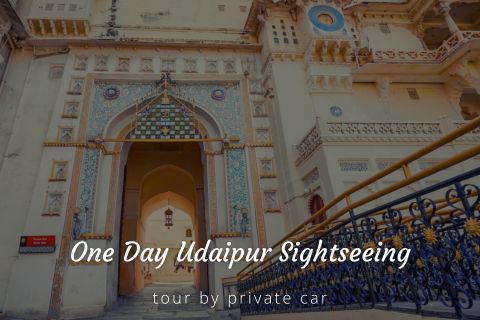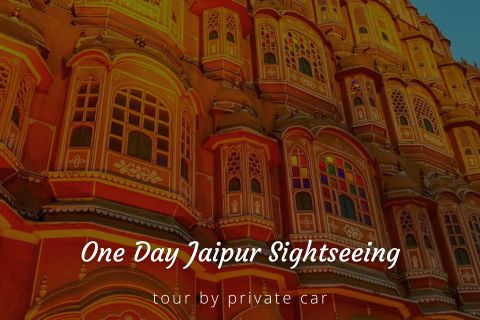
Bagore Ki Haveli Udaipur Entry Fee
- 60 per person for Domestic Adult
- 30 per person for Domestic Children (Age between 5 to 12)
- 100 per person for Foreign Adult
- 50 per person for Foreign Child
- 50 for Camera / Video
- 90 per person for Indians
- 45 per person for Children
- 150 per person for Foreign Adult
- 75 per person for Foreign Child
- 150 for Any Camera
Dharohar Dance Show entry fee
Bagore Ki Haveli Udaipur Phone
02942 482322
02942 422567
Rating:  | 4/5 stars
| 4/5 stars
Based on total 89 reviews
Udaipur Tour Packages
Udaipur Tour PackagesBagore Ki Haveli Udaipur Timings
| Day | Timing |
|---|---|
| Monday | 9:30 am – 5:30 pm |
| Tuesday | 9:30 am – 5:30 pm |
| Wednesday | 9:30 am – 5:30 pm |
| Thursday | 9:30 am – 5:30 pm |
| Friday | 9:30 am – 5:30 pm |
| Saturday | 9:30 am – 5:30 pm |
| Sunday | 9:30 am – 5:30 pm |
Note: The Dharohar Dance Show Timings are from 7:00 pm to 8:00 pm & the show tickets available from 6:15 pm
Links: Website | MapBagore Ki Haveli Udaipur Address: Old City, Pichola, Udaipur, Rajasthan, 313004, India
One of the famous places to visit in Udaipur, Bagore Ki Haveli is a haveli that stands magnificently on the waterfront of the surreal Lake Pichola at Gangori Ghat. Built in the 18th century by Amar Chand Badwa, the then Prime minister of Mewar kingdom, Bagore Ki Haveli has been restored over the period of time and is now converted into a museum.
History of Bagore Ki Haveli
Shri Amarchand Badwa, who served as the Prime minister of Mewar kingdom during the reign of Maharanas Pratap Singh II, Raj Singh II, Ari Singh, and Hamir Singh from the period of 1751 to 1778, built Bagore Ki Haveli. Following the death of Amarchand Badwa, the haveli came under the possession of Mewar royal family and became the abode of Nath Singh, a relative of the then Maharana.
In 1878, Maharaj Shakti Singh of Bagore further extended the haveli by building the triple-arched gateway and since then it is known as Bagore ki Haveli. Till 1947, the haveli remained in the possession of Mewar state.
Post India’s Independence, the Haveli was used by the Rajasthan government for housing government employees. The haveli was neglected for almost forty years and later in 1986, the Government eventually decided to handover the restoration work to the West Zone Cultural Centre.
Restoration of Bagore ki Haveli
The West Zone Cultural Centre converted the haveli into a museum, while retaining the royal look in the same old architectural style. To maintain its old charm, several royal family members were consulted and the Haveli was restored using local and traditional skills.
The materials used for the restoration of Bagore ki Haveli included the traditional materials like lakhori bricks and lime mortar. The existing murals were preserved and the doors, windows and perforated screens were repaired and the extremely damaged ones were replaced.
Image Gallery of Bagore Ki Haveli Udaipur
Architecture of Bagore ki Haveli
Any art lover would love to explore the Bagore ki Haveli for its splendid architecture and skillful craftsmanship. Reflecting the Mewar’s aristocratic culture, Bagore ki Haveli is a marvellous assortment of huge courtyards, balconies, jharokhas, decorative archways, cupolas and a fountain.
With around 138 rooms, the interiors of the Haveli are decorated with exceptional mirror work. The walls of the Haveli are adorned beautifully with alluring glasswork and mural paintings. One can see various rooms used by the royal family that are worth admiring for its finest craftsmanship.
The Chambers of the Royal Ladies is one place that is worth visiting for its renowned glass windows that are colored beautifully. It houses two peacocks made with coloured glass mosaic that are exceptionally crafted.
An Insight into the Bagore ki Haveli
As one enters the gates of the Haveli, an attractive courtyard with an equally attractive two storied Lotus fountain greets them. Bagore ki Haveli has three chowks namely Kuan Chowk, Neem Chowk and Tulsi Chowk.
Kuan Chown or the Well court is located on the ground floor of the Bagore ki Haveli which was used to house stores and stables and served as the place where day to day household chores of the staff were performed.
Neem Chowk on the first floor of the Haveli is covered by attractive brass doors and was the stage for music and dance performances that were enjoyed by the royal men. Even now the place displays various performing art forms.
The Kanch Mahal (mirrored passage) and Durrie Khana were other restricted areas used only by the men of the royal family. Diwan-e-khas was the largest chamber in the Haveli which is now occupied by the office of the Director, WZCC.
Tulsi Chowk, on the other hand was the prime area for the princesses which also housed the zenana, the women’s quarters. This Chowk was the arena for festival celebrations and Ghoomar performance by the ladies of the Haveli.
Now, the Chowk displays a beautiful collection of turbans and women’s costumes. Tulsi Chowk houses a gallery that reminisces of Haveli’s golden days.
Bagore ki Haveli also has Shringar Kaksh, a dressing room used by the women of the Haveli. It contains a wooden trunk used by the princesses to store their possessions. One can also find Itra Daan, a perfume used by the royal women in this room.
Women in the Haveli were also interested in music and Sangeet Kaksh in the Haveli was used by the royal women to learn music and indulge in playing music instruments such as santoor, chang, dholak, nagada, sarangi, etc.
Manoranjan Kaksh was the place where men enjoyed playing board games and exhibits games like chaupad and ganjifa.
The Museum
Bagore ki Haveli museum is divided into five sections namely The Puppet museum, the main haveli, the Turban museum, the Weapon museum, the Wedding Depiction Section. Each of these sections is very well maintained.
1. Puppet Museum at Bagore ki Haveli
A favourite among kids, Puppet museum has a display of a number of puppets. The entrance of the museum greets one with miniature puppets and other decor items that are handmade.
At one side of the room, one can see a section dedicated to king’s courtroom setup in the form of puppets, with the king, queen and various other ministers sitting in their seats. One can also see puppets of horses, elephants, and many other dolls in various shapes and sizes in the museum.
One can also buy puppets from the museum at a nominal price. An integral part of the Rajasthani culture, this puppet museum is worth a visit especially when visiting with kids.
2. Haveli museum
A flight of stairs leads one to the terrace that offers breathtaking view of the Lake Pichola. One can also see other important landmarks across the lake such as Oberoi Udaivilas Palace Hotel, Taj Hotel, and City Palace from the terrace.
As one strolls through the Haveli, they come across lobbies leading them to various rooms of the Haveli such as the private quarters of the royal ladies, their bathrooms, dressing rooms, bed rooms, living rooms, worship rooms and recreation rooms. The rooms are set up in the old style that showcase how the royal family used to live once.
The bedrooms are set up with an old bed in the corner and the regular stuff that old bedrooms used to comprise of. Likewise, there is a living room with rugs on the floor and beautiful cushions, along with dolls or puppets of people sitting around. Also, a kitchen with earthen pots used during olden days can be seen here.
The walls of the lobby are adorned with a number of beautiful paintings depicting scenes from the royal era. Paintings of women doing household chores, enjoying scenery at Lake Pichola, kings preparing for war can be seen here. Another painting depicting the family hierarchy of residents of Bagore ki Haveli can also be seen.
Items that belonged to the Rajputs such as costumes wore by the kings, jewellery boxes, dice games, hookahs, rose water sprinklers can be seen in the museum.
The Basement of the museum displays an array of collection of skillful art work that attracts visitors. In addition, the historical Indra Viman or the Elephant Chariot that belonged to the kings of Jhalawar is also present in the museum.
Another latest addition to the museum is the thermocol model of Bagore Ki Haveli along with the existing sculptures of Eiffel Tower, the Victory Tower of Chittorgarh, the Taj Mahal, the Leaning Tower of Pisa that are worth admiring.
A beautiful swing hanging from the roof in the lobby of the first floor is another attraction that showcases how the ancient ladies used to enjoy swinging here.
3. The Turban section at Bagore ki Haveli
Located on the ground floor of the Haveli, the Turban section showcases various turbans from different states of India such as Punjab, Haryana, Rajasthan and Gujarat. One gets insight into how people from different states wear their turbans which is an integral part of their culture.
In Punjab, turbans are made of plain cloths in different colors while Rajasthani turbans are more of vibrant colors typically made of tie-dye fabric. Gujrati turbans are quite similar to Rajasthani ones while differing in colors and sizes.
4. Weapons section at Bagore ki Haveli
Located right beside the entrance, weapons section of the museum is comparatively a smaller section. It showcases various weapons used by the kings and their armies during battle.
5. The Wedding section at Bagore ki Haveli
Another attraction of Bagore ki Haveli, the wedding section is also a smaller section that depicts different stages of an Indian wedding in the form of dolls or puppets.
This section gives an insight into the various rituals and customs followed in a traditional Indian wedding, right from muhurat fixation to wedding to post wedding rituals which is both enlightening as well as entertaining.
Dharohar Dance Show at Bagore ki Haveli
The main attraction of Bagore ki Haveli is the Dharohar Dance Show that is conducted in the evenings starting around 7 pm. This hour long show takes place in the courtyard called as the Neem Chowk. The beautifully lit up balconies of the Neem chowk add charm to the Haveli setting up a stage for the traditional Rajasthani folk dance and music.
Seating arrangements are made on the floor around the stage. The floor is arranged with large mattresses placed around the three sides of the terrace to get a good view of the dance performances.
The Dharohar Dance Show is very well organized starting with a brief introduction given by a Rajasthani woman dressed in a traditional Rajasthani attire. The performances are preceded by the beating of a drum, blowing of a conch shell and a religious song.
The show consists of well choreographed dances ably supported by the musicians playing tabla and harmonium. The women performing the dance wear typical Rajasthani folk costumes with colorful ghagra cholis embodied with glass work and embroidery work.
The first dance performance is called Chari Dance where the performers dance with lit brass pots on their head skillfully balancing them.
The next dance performance called as Terha Taal Dance needs perfect coordination skills as the dancers play 13 manjiras (bells) tied to their hands and legs according to the rhythm of the music. At one point of time in the performance they hold a knife in their mouth along with a set of brass pots on their head as well as play manjiras, all at the same time quite skillfully.
The Gorbandh Dance is the next performance where the dancers perform wearing ornaments used to adorn camels and dance in complete abandon. Women twirling in high speed while holding hands, this performance is sure to remind one of their childhood days.
Taking a detour from the dance performances, the next one is Rajasthani Puppet show which caters to young kids in the audience. The comical skits performed with the puppets add humour to the show.
Next in the line of performances is the high class dance performance known as Ghumar Dance where the dancers dance in rhythmic circles according to the music accompanying it.
The final performance of the show is called Bhavani dance where performer dances with earthen pots on her head. This performance is the most difficult ones as the performer dances with two pots to upto 13 pots on her head while performing various acts including standing on a broken glass.
The Dharohar dance show at the Bagore-ki-Haveli is a colorful and vibrant show that showcases tradition and culture of the Rajasthani folklore in an interesting manner. The skills and artistry of the performers are definitely worth admiring and should not be missed by anyone visiting this beautiful Haveli.
Entry Fee of Bagore ki Haveli
The Ticket price for Bagore ki Haveli Museum is Rs. 60 for Indian Adults and Rs. 30 for Indian Children aged between 5 to 12 years. The Entry fee for Foreigners is Rs. 100 for Adults and Rs. 50 for Children. Cameras are charged at Rs. 50.
For Dharohar Dance show, the tickets are priced at Rs. 90 for Indian Adults and Rs. 45 for Indian Children. For foreigners, the ticket fee is Rs. 150 for Adults and Rs. 75 for Children. Cameras are charged at Rs. 150.
Timings of Bagore ki Haveli
Bagore ki Haveli Museum timings are from 9:30 am to 5:30 pm on all days of the week.
The Dharohar Dance Show Timings are from 7:00 pm to 8:00 pm on all days of the week. Tickets for the Dance show are available from 6:15 pm.
Timings may vary on special occasions and festivals.
Availability of Guides at Bagore ki Haveli
Guides are available at the grounds of Bagore ki Haveli who give a detailed insight of the Haveli complex at a nominal fee.
Best Time to visit Bagore ki Haveli
Winter months from September to March are considered as the Best months to visit Bagore ki Haveli as the weather is quite pleasant during this time with the maximum temperature reaching just around 28.3°C.
It is advisable not to visit the Haveli during summers to avoid the extreme heat of the city.
How to Reach Bagore ki Haveli
Bagore ki Haveli is located in the Old city of Udaipur which is within the range of 1.5 km radius from the city center. The Haveli is well connected by local buses, auto rickshaws and taxis. You can also book a private cab from top car rental companies in Udaipur to reach the haveli conveniently.
The Haveli is at a short distance from the airport and Railway station as well. Maharana Pratap airport is the nearest airport which is 23.3 km away and Udaipur Railway station is the nearest railway station at a distance of 2.4 km away from the Haveli.
Udaipur is well connected to other cities with a number of government operated buses and private buses plying to and from Udaipur to major cities.
Udaipur offers a lot to its visitors with its rich culture, heritage and magnificent palaces. One such place that truly represents the spirit of Rajasthani culture and traditions is Bagore ki Haveli that should not be missed by anyone visiting the City of Palaces. Udaipur Tourism, a division of Holidays DNA helps you explore this beautiful city to the fullest with its Udaipur Tour packages. To know more, please fill the Contact Us form.




